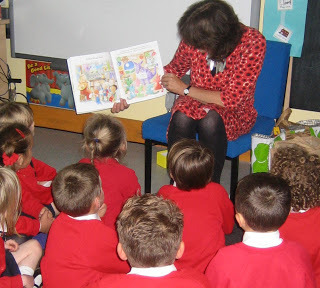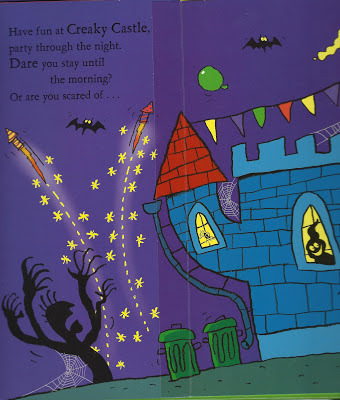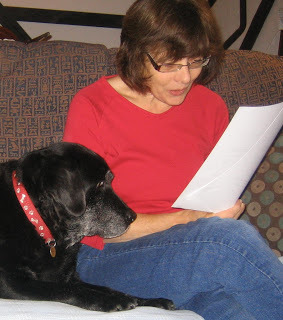What I've learned from reading aloud, by Jane Clarke
Picture books are designed to be read out loud by an adult sitting next to a child – and I adored reading them that way to my sons when they were small. Later on, as a library assistant at Antwerp International School, I read face to face, holding the books open and reading the words upside down and sideways, so that a whole class of children could see the pictures. I often do that today, on author visits to schools.

Back them, I had no idea that I would end up writing picture books – but without realising it, I absorbed the pace and cadence of a picture book, and I learned:
Different characters have different voices.
 From Trumpet the Little Elephant with the Big Temper, illustrated by Charles Fuge
From Trumpet the Little Elephant with the Big Temper, illustrated by Charles Fuge
Page turns have drama.

 From Creaky Castle, illustrated by Christyan Fox
From Creaky Castle, illustrated by Christyan Fox
There are opportunities to vary the speed and tone of the reading. From Knight Time, illustrated by Jane Massey
From Knight Time, illustrated by Jane Massey
Words can be enjoyed for their sound and rhythm.
 From Dance Together Dinosaurs, illustrated by Lee Wildish
From Dance Together Dinosaurs, illustrated by Lee Wildish
Jokes and puns in the words and the pictures can be quite sophisticated and enjoyed on two levels – the adult and the child.
 From Gilbert the Great, illustrated by Charles Fuge. Charlie slipped in some pictorial references to the Jaws movies.
From Gilbert the Great, illustrated by Charles Fuge. Charlie slipped in some pictorial references to the Jaws movies.
It’s fun to join in a refrain (but don’t overdo it).
 From Stuck in the Mud, illustrated by Garry Parsons
From Stuck in the Mud, illustrated by Garry Parsons
Reading out loud is an important part of the process when you’re writing picture books. It helps highlight where the text isn’t working. I find it hard to read into thin air, but I can usually find an audience of some sort...

Some picture books work best snuggled up quietly, some work best shared with large groups of noisy youngsters. What picture books do you love to read out loud?


Back them, I had no idea that I would end up writing picture books – but without realising it, I absorbed the pace and cadence of a picture book, and I learned:
Different characters have different voices.
 From Trumpet the Little Elephant with the Big Temper, illustrated by Charles Fuge
From Trumpet the Little Elephant with the Big Temper, illustrated by Charles FugePage turns have drama.

 From Creaky Castle, illustrated by Christyan Fox
From Creaky Castle, illustrated by Christyan FoxThere are opportunities to vary the speed and tone of the reading.
 From Knight Time, illustrated by Jane Massey
From Knight Time, illustrated by Jane Massey
Words can be enjoyed for their sound and rhythm.
 From Dance Together Dinosaurs, illustrated by Lee Wildish
From Dance Together Dinosaurs, illustrated by Lee WildishJokes and puns in the words and the pictures can be quite sophisticated and enjoyed on two levels – the adult and the child.
 From Gilbert the Great, illustrated by Charles Fuge. Charlie slipped in some pictorial references to the Jaws movies.
From Gilbert the Great, illustrated by Charles Fuge. Charlie slipped in some pictorial references to the Jaws movies.It’s fun to join in a refrain (but don’t overdo it).
 From Stuck in the Mud, illustrated by Garry Parsons
From Stuck in the Mud, illustrated by Garry ParsonsReading out loud is an important part of the process when you’re writing picture books. It helps highlight where the text isn’t working. I find it hard to read into thin air, but I can usually find an audience of some sort...

Some picture books work best snuggled up quietly, some work best shared with large groups of noisy youngsters. What picture books do you love to read out loud?
Published on November 10, 2012 00:00
No comments have been added yet.



